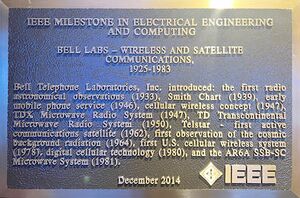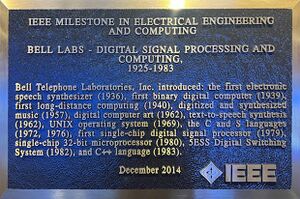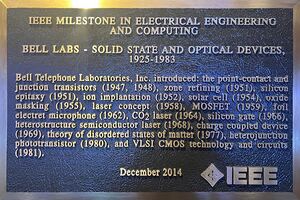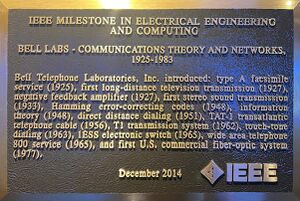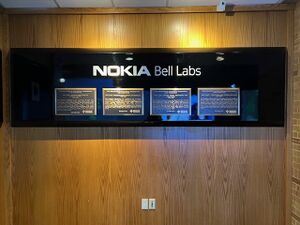Milestones:Bell Telephone Laboratories, Inc., 1925-1983
- Date Dedicated
- 2014/12/18
- Dedication #
- 151
- Location
- Murray Hill, NJ, U.S.A.
- IEEE Regions
- 1
- IEEE sections
- North Jersey
- Achievement date range
- 1925-1983
Title
Bell Telephone Laboratories, Inc., 1925-1983
Citation
There are four plaques in order to provide space to list the achievements.
BELL LABS – WIRELESS AND SATELLITE COMMUNICATIONS, 1925-1983
Bell Telephone Laboratories, Inc. introduced: the first radio astronomical observations (1933), Smith Chart (1939), early mobile phone service (1946), cellular wireless concept (1947), TDX Microwave Radio System (1947), TD Transcontinental Microwave Radio System (1950), Telstar - first active communications satellite (1962), first observation of the cosmic background radiation (1964), first U.S. cellular wireless system (1978), digital cellular technology (1980), and the AR6A SSB-SC Microwave System (1981).
BELL LABS - DIGITAL SIGNAL PROCESSING AND COMPUTING, 1925-1983
Bell Telephone Laboratories, Inc. introduced: the first electronic speech synthesizer (1936), first binary digital computer (1939), first long-distance computing (1940), digitized and synthesized music (1957), digital computer art (1962), text-to-speech synthesis (1962), UNIX operating system (1969), the C and S languages (1972, 1976), first single-chip digital signal processor (1979), single-chip 32-bit microprocessor (1980), 5ESS Digital Switching System (1982), and C++ language (1983).
BELL LABS - SOLID STATE AND OPTICAL DEVICES, 1925-1983
Bell Telephone Laboratories, Inc. introduced: the point-contact and junction transistors (1947, 1948), zone refining (1951), silicon epitaxy (1951), ion implantation (1952), solar cell (1954), oxide masking (1955), laser concept (1958), MOSFET (1959), foil electret microphone (1962), CO2 laser (1964), silicon gate (1966), heterostructure semiconductor laser (1968), charge coupled device (1969), theory of disordered states of matter (1977), heterojunction phototransistor (1980), and VLSI CMOS technology and circuits (1981).
BELL LABS - COMMUNICATIONS THEORY AND NETWORKS, 1925-1983
Bell Telephone Laboratories, Inc. introduced: type A facsimile service (1925), first long-distance television transmission (1927), negative feedback amplifier (1927), first stereo sound transmission (1933), Hamming error-correcting codes (1948), information theory (1948), direct distance dialing (1951), TAT-1 transatlantic telephone cable (1956), T1 transmission system (1962), touch-tone dialing (1963), 1ESS electronic switch (1965), wide area telephone 800 service (1965), and first U.S. commercial fiber-optic system (1977).
Street address(es) and GPS coordinates of the Milestone Plaque Sites
Nokia Bell Labs, Bldg. 6, 600 Mountain Ave, Murray Hill, NJ 07974 US (40.684042, -74.400856)
Details of the physical location of the plaque
The 4 plaques are mounted side-by-side on a special mounting board on a wall inside the Main Lobby, behind the security guard’s desk
How the plaque site is protected/secured
Building security; accessible from 8am-5pm on non-holiday weekdays. Visitors must request admission to see the plaque at least 48 hours in advance, and with an arrival time in the range of 8:30am-4pm (the site is open until 5 pm). Do so by emailing your date/time request to info@bell-labs.com to receive a confirmation. Visitors will check in with security, and will receive a guest badge and have an escort take them to the plaques. They may also see two other IEEE Milestone plaques without a security escort: the First Transistor plaque inside the Main Lobby, and the Information Theory plaque outside the Main Lobby.
Historical significance of the work
Bell Labs transformed the way people communicate at work and home through the invention and development of many technical innovations that were necessary for the modern telecommunication systems and other advanced technologies. From its founding in 1925, Bell Telephone Laboratories made numerous significant contributions to telecommunications and related fields that led to the information age and the digital era. Some of these contributions include: information theory, systems engineering, digital signal processing, digital transmission and switching, data networking, cellular systems, (800) service, the transistor, solar cell, integrated circuit technology, communication satellites, high capacity undersea cable, touch-tone dialing, voice and video compression, and the Unix operating system.
The following provides a brief summary description of some of the most significant innovations at Bell Labs within the 1925-83 time period that are in the milestone citation.
Information Theory was developed by Claude E. Shannon at Bell Telephone Laboratories to find fundamental limits on signal processing operations such as compressing data and on reliably storing and communicating data. It is the fundamental underpinnings of modern computer and communications technology.
Systems engineering is the interdisciplinary field of engineering that focuses on how complex engineering projects should be designed and managed over the life cycle of the project. It originated in Bell Telephone Laboratories in the 1940s for the development and implementation of complex systems. It is widely used by companies and government organizations. The NASA Apollo Project and the International Space Station are an examples of such projects using systems engineering.
The UNIX operating System and C programming language were created at Bell Labs between 1969 and 1972. UNIX made large-scale networking of diverse computing systems - and the Internet - practical. UNIX and its spin-offs are the operating system of most large computers, Internet servers, and smart phones. The C language brought an unprecedented combination of efficiency and expressiveness to programming. C and its descendants are the most widely used programming languages in the world.
The Transistor was invented in 1947 as a replacement for bulky and inefficient vacuum tubes and mechanical relays. The transistor revolutionized the entire electronics world. The transistor sparked a new era of modern technical accomplishments from manned space flight and computers to portable radios and stereos. As embodied in integrated circuits, it is the basic building block of modern electronics and is manufactured by the multi- billions every year.
The first practical Solar cell was developed in Bell Labs in 1954. It converts the sun’s energy into electricity. It was first used on a large scale for satellites and is now an important factor in the sustainable creation of electricity.
Cellular systems were first proposed in 1947 Bell Labs publications. The primary innovation was the development of a network of small overlapping cell sites supported by a call switching infrastructure that tracks users as they moved through a network and pass their call from one site to another without dropping the connection. Bell Labs installed the first commercial cellular network in Chicago in the 1970s. Today, it is the basis of a rapidly growing cellular and mobile smart phone industry.
The first high capacity transatlantic telephone cable, which was based on innovations from Bell Labs, was deployed in 1956.
Bell Labs was the pioneer in communications satellites. In 1962 it built and successfully launched the first orbiting active communications satellite (Telstar I), which transmitted the first live television across the Atlantic.
Digital transmission and electronic switching; In 1962, Bell Labs developed the first digitally multiplexed transmission of voice signals. This innovation not only created a more economical, robust and flexible network design for voice traffic, but also laid the groundwork for today's advanced network services such as 911, 800-numbers, call-waiting and caller-ID. In addition, digital networking was the foundation for the convergence of computing and communications. LASER - the invention of the laser, which stands for “Light Amplification by Stimulated Emission of Radiation,” originated in 1958 with the publication of a scientific paper by Bell Labs researchers. Lasers launched a new scientific field and opened the door to a multi-billion-dollar industry that includes applications in medicine, communications, and consumer electronics.
Bell Labs built the first single-chip digital signal processor in 1979. The DSP is the engine of today's multimedia revolution. DSP technology is in multimedia PCs and in the modems that connect computers to the Internet. It's in wireless phones, answering machines, and voice-mail; it's in video games talking toys, DVD players and digital cameras.
Dedication ceremony
Supporting materials
Map
